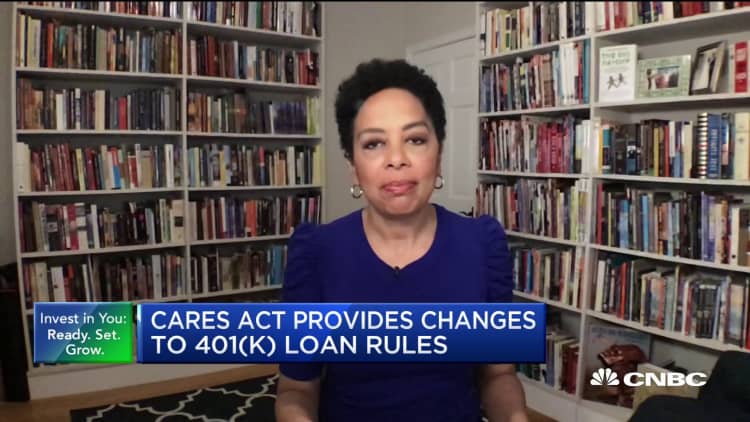With coronavirus shutdowns wreaking havoc on the global economy, investment portfolios are also getting battered. The S&P 500 is down more than 10% since the start of the year.
While that's unpleasant for most investors, it's especially devastating for retirees who count on their investments for income. And when those declines come at the beginning of retirement, they can permanently lock in a lower nest egg, known as sequence of return risk.
"The best thing to do is not take money out when the market has gone down," said Mark Orr, a certified financial planner with Retirement Wealth Advisors and author of "Retirement Income Planning: The Baby-Boomers 2020 Guide to Maximize Your Income and Make It Last."
But that's not an option available to everyone. One strategy financial advisors increasingly talk about that can allow retirees to come up with income and ride out a market decline is a reverse mortgage.
Not surprising, applications for new reverse mortgages have shot up in recent weeks. According to the Reverse Mortgage Insight, which gathers data on the industry, applications for home equity conversion mortgage, or HECM, the most common type of reverse mortgage that is insured by the Federal Housing Administration, were up 15% in March. Applications were up 50% in Q1 compared to the same period last year. The organization does not yet have figures for April.
"A reverse mortgage could be a secondary source of cash," explains John Salter, professor of personal financial planning at Texas Tech University and a partner at Evensky & Katz Wealth Management.

Salter, along with Harold Evensky and Shaun Pfeiffer, is the author of two papers in the Journal of Financial Planning outlining how a reverse mortgage can reduce sequence of return risk.
Reverse mortgage nuts and bolts
Unlike a traditional mortgage, a reverse mortgage allows older homeowners to take out some of their home equity without having to pay it back so long as they stay in their homes. An individual must be 62 years-old or older to qualify for a reverse mortgage.
There are three factors that determine how much money you can borrow: the age of the youngest borrower (the older you are, the more you can borrow), interest rates and the home's appraised value. The maximum amount you can take out is $765,600, even if the home is valued at more. Borrowers who still have a mortgage on their home must use part of their reverse mortgage to pay that off first.
Interest rates on reverse mortgages typically are adjustable, but they are comparable to traditional mortgages plus 0.5% of the outstanding mortgage balance for a mortgage insurance premium. Adjustable HECM rates were 4.01% in March, according to HUD.
However, reverse mortgages can be complicated, and there are a few catches.
More from Invest in You:
Struggling to pay your mortgage? Here's how to get help
These 3 tweaks will simplify your money. Because life is complicated enough
This simple financial plan makes it easier to get through tough times
To keep a reverse mortgage in place, homeowners must continue to pay property insurance, be current on property taxes and maintain their home. Not doing those things could result in foreclosure, though advisors note that not paying your property taxes could lead to foreclosure even without a reverse mortgage.
Second, interest accrues throughout the life of the loan, so your loan balance continually gets bigger and could surpass the value of the home. Anyone who wants to leave their home to the children won't be able to do so.
On the other hand, reverse mortgages are considered to be "non-recourse loans."
"There's a stopgap on what your debt could become, so even if your mortgage is under water, all you ever owe is the value of your home," explains Jamie Hopkins, director of retirement research at Carson Wealth.
That's where the insurance premium comes in. It protects lenders from loaning out more than the value of the home.
Three funding options
Money from a reverse mortgage is not taxable, because it's considered a use of the equity in your home.
There are three ways to receive payment from a reverse mortgage. The first is a lump sum, in which you get your loan upfront. Financial planners usually warn against this for fear that retirees could blow through their money quickly.
"That's really not the purpose of a reverse mortgage," said Jim Holtzman, a certified financial planner with Legend Financial Advisors in Pittsburgh.

Another option is an annuity, which provides regular monthly while you remain in the home. There is an actuarial formula for how much money you can receive based largely on your age. Finally, there is the line of credit, which is the option that reverse mortgage advocates like Salter and Hopkins like the most. The line of credit earns interest (at about the same as the borrowing rate) until you tap it, so it could potentially grow to an even more sizable pot of money.
"The line of credit has the most flexibility," said Holtzman acknowledges.
Orr recommends that retirees establish the line of credit early in retirement and allow it to grow until they need it for retirement income during periods of market decline.
"You have this growing asset that can be used for sequence of return protection," he said.
Advisors taking a second look
For many years advisors took a dim view of reverse mortgages. In the early days the industry was riddled with horror stories about homeowners spending down their lump sums and not having enough money to pay their taxes, insurance and maintenance.
The HECM program has addressed these concerns by instituting some changes. Now borrowers are only able to access up to 60% of their loan value in the first year. In addition, lenders also conduct a financial assessment of borrowers to make sure they have the financial wherewithal to pay the expenses associated with a home. And borrowers must also go through — and pay for — counseling with a government-approved counselor.
"I changed my attitude toward them probably three years ago," said Rick Kahler, president of Kahler Financial Group. "Prior to that I didn't see a place for them."
What's more, reverse mortgage lines of credit can be accessed when other funding sources dry up. For example, JPMorgan Chase temporarily suspended its home equity line of credit program in mid-April due to surging demand.
Some concerns remain
Though reverse mortgages have gained acceptance for use as a retirement income management tool, advisors still maintain that they are only appropriate in certain circumstances.
In 2017 the Department of Housing and Urban Development made changes to the HECM program, making the line of credit less attractive. Among changes is that borrowers must pay a 2% mortgage insurance premium upfront, instead of on an ongoing basis.
Previously, borrowers who took out less than 60% of their home value paid 0.5% in insurance and those who took out more paid 2.5%. Now all borrowers pay the same. That can make a reverse mortgage among the most expensive loans you can get.
"Everything kind of falls apart when you move before tapping your line of credit," said Kahler. Advisors caution anyone who is interested in using a reverse mortgage strategy to make sure their home is one where they can "age in place" or move to one where they can. Otherwise, they might be paying a lot in upfront fees before tapping the full line of credit.In addition, borrowers are able to access less of their home equity, on average about 58%, down from 64%.
Perhaps the biggest hurdle for reverse mortgages is borrowers themselves. "My clients say to me, "I've spent my whole life paying off my mortgage and now you're telling me you want me to put a mortgage on my property?" said Kahler.
SIGN UP: Money 101 is an 8-week learning course to financial freedom, delivered weekly to your inbox.
CHECK OUT: What to do if you think your stimulus check is for the wrong amount via Grow with Acorns+CNBC.
Disclosure: NBCUniversal and Comcast Ventures are investors in Acorns.





